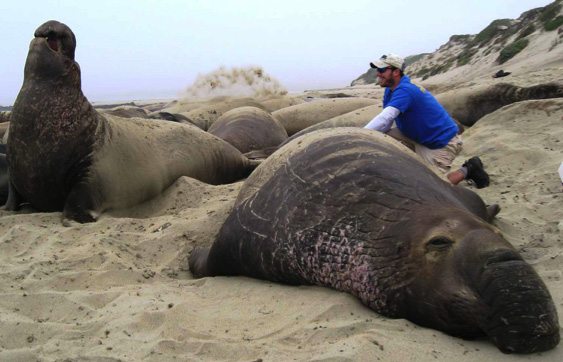
Michael Tift collecting a blood sample to investigate the level of naturally produced carbon monoxide (CO) in a sedated adult male northern elephant seal. Photo Credit: Michael Tift
More than two thousand years ago in Ancient Greece, Aristotle recorded toxic fumes released by burning coals, undoubtedly a reference to
carbon monoxide (CO).
Century after century since Aristotle, chemists,
alchemists,
and other curious minds have made similar findings. The English chemist, Joseph Priestly, is usually credited with the discovery of CO, as distinct from
carbon dioxide (CO2),
in the late
1700s.
Today there are many regulations in place to protect unwitting humans from accidental exposure to carbon monoxide, and carbon monoxide detectors are just as important in our homes as smoke detectors.
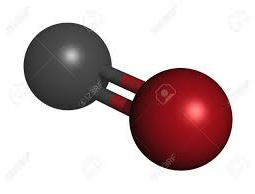
Carbon monoxide molecule
The toxicity of
carbon monoxide
gas has been recognized by humans for millennia.

Left:Aristotle Right:Joseph Priestly
How does carbon monoxide kill? Carbon monoxide affects the ability of the body to transport oxygen through the bloodstream. In a healthy person, oxygen in air enters the body through the lungs, binds to the oxygen-carrying protein
hemoglobin,
which travels throughout the bloodstream delivering oxygen to our tissues. When we inhale carbon monoxide, it binds to hemoglobin much more tightly than oxygen (~ 240 times stronger bond). This tight bond prevents additional oxygen molecules from binding to hemoglobin, and also prevents the delivery of any oxygen still bound to the same hemoglobin as the CO. If enough CO enters our bloodstream, sufficient oxygen delivery to tissues and organs throughout the body is restricted, and this is what leads to carbon monoxide poisoning. An inadequate supply of oxygen to our tissues is known as
hypoxia.
A prolonged state of tissue hypoxia can be fatal.
Moderate amounts of CO may be beneficial
Although CO can be toxic at high levels, it is a naturally-occurring molecule that can be found at low levels in the human body. This is because CO is the natural by-product of the breakdown of heme, found in hemoglobin, and many other common heme proteins. In fact, some researchers have suggested that CO could be beneficial at moderate, controlled doses for certain
conditions.
Recent findings suggest that these moderate amounts of CO could provide protection against tissue damage as a result of lack of blood flow and oxygen. In humans, this is relevant for conditions such as
heart disease,
sepsis,
shock,
and
organ transplant.
There are two common methods for measuring CO in the body. The primary method is to examine the percent of hemoglobin stores in the body that are bound to carbon monoxide (carboxyhemoglobin: COHb) in a blood sample. A newer method is to examine the amount of carbon monoxide in an exhaled breath sample, measured as parts per million, ppm CO. This second method works because the primary pathway for CO to leave the body is via the lungs. In humans and other mammals, there is a positive relationship between the levels of CO in the blood and exhaled breath.
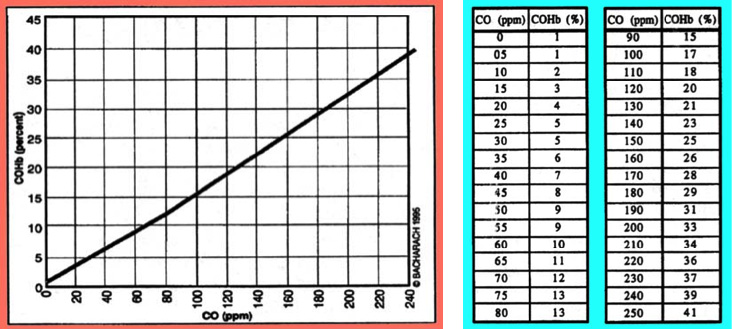
Left panel describes the relationship of expired CO (ppm) to blood carboxyhemoglobin (COHb, %). The right panel is a conversion table of CO to COHb Source: http://www.coheadquarters.com/CODanger/codanger14.htm
Most data related to CO and health are focused on CO poisoning. However, the natural world may provide clues into adaptations for CO and the potential benefits of carbon monoxide in the body. New research by Michael Tift in the laboratory of Dr. Paul Ponganis at Scripps Institution of Oceanography, University of California at San Diego recommends one such animal model: northern elephant seals.
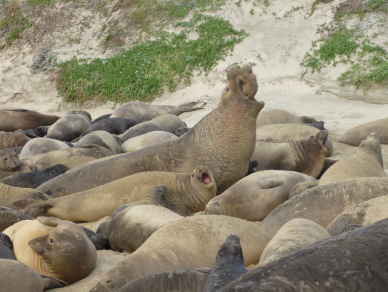
Harem of northern elephant seals (Mirounga angustirostris). One alpha male surrounded by several adult females and their pups. Photo: Michael Tift
Northern elephant seals spend nearly 90% of their lives underwater.
The northern elephant seal, Mirounga angustirostris, is a large marine mammal found off the Pacific coast from Canada to Mexico. Northern elephant seals are unique among marine mammals in the amount of time they spend underwater, nearly 90% of their lives. They only come on land twice per year, during breeding and
molting
seasons, but otherwise they are typically found out in the middle of the Pacific Ocean at sea, diving for up to 90 minutes at maximum depths of nearly 5,500 feet (over a mile).
To conserve energy during dives, the heart rate of elephant seals can drop dramatically to as low as
3 beats per minute.
In order to maintain blood pressure to stay alive with this low heart rate, blood flow is reduced in peripheral tissues
(ischemia),
driving many tissues and organs into a temporary state of hypoxia. When the elephant seals resurface to take a breath, heart rate increases and the peripheral tissues are
reperfused
with oxygenated blood.
In humans, this process of continued ischemia and reperfusion, even on a much shorter time scale, can be disastrous for the body. Elephant seals, however, appear to be well adapted to their environment and lifestyle. They have one of the highest mass-specific blood volumes and hemoglobin concentrations seen amongst mammals. Considering hemoglobin is a primary source for carbon monoxide production in humans, the seals have the potential to produce large quantities of carbon monoxide. “I wanted to better understand some of those adaptations,” comments Michael Tift.
In the Arctic in the 1950’s
Tift’s interest in carbon monoxide in marine mammals was sparked by a research paper written in the late 1950’s, where a scientist was investigating carbon monoxide exposure in men working in Antarctica. To test his apparatus for measuring carbon monoxide in blood, he first tried to measure the levels of carbon monoxide in Weddell seals (Leptonychotes weddelli), and found the values to be as high as those reported in cigarette
smokers.
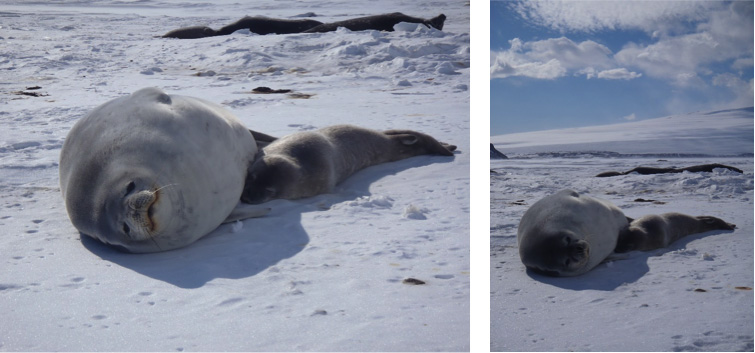
Adult female Weddell seal and her pup in Antarctica. Photo credits: Luis Huckstadt
Compared to the Weddell seal, northern elephant seals are larger animals and spend much more time under water. However, both the elephant seals and Weddell seals have high hemoglobin and blood volume stores when compared to most other mammals. This increases their potential for natural carbon monoxide production. “Given this previous study’s findings about increased carbon monoxide in Weddell seals and the new research showing potential benefits of moderate carbon monoxide levels, I wanted to examine the levels of carbon monoxide in different marine mammal species,” Tift recalls.
With permission from the National Marine Fisheries Service, Tift measured the levels of carbon monoxide in the breath and blood from 24 northern elephant seals, 9
killer whales,
7
bottlenose dolphins,
5
beluga whales,
3
pilot whales,
and 1
Hawaiian monk seal
(breath samples only). Analysis of the breath and blood samples revealed levels of CO were positively related to hemoglobin stores in the different species. However, the magnitude of carbon monoxide was significantly higher in the elephant seal compared to all other species.
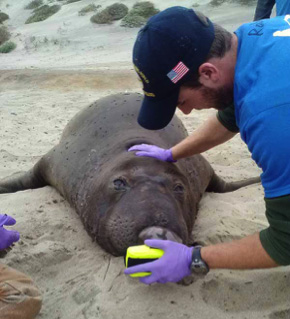
Michael Tift collecting an end-tidal carbon monoxide (CO) sample from a sedated sub-adult male northern elephant seal. Photo Credit: Michael Tift
Understanding this process could provide needed insight into a variety of disease states in humans that are caused by lack of oxygen.
Why? Tift hypothesizes that the higher concentration of CO found in the blood of northern elephant seals is a result of their larger mass-specific blood volumes and hemoglobin stores. He expects these moderate levels of CO act as a protective mechanism from ischemia-reperfusion events that occur during their extreme dives. Understanding this process could provide needed insight into a variety of disease states in humans that are caused by lack of oxygen.
In future work, Tift plans to further analyze the blood samples obtained for
enzymes
related to the breakdown of hemoglobin, a process that naturally releases carbon monoxide, as well as the expression of relevant genes. More broadly, Tift plans to investigate how northern elephant seals and other free-ranging marine mammals store oxygen in the blood, especially during long dives. As Tift remarks: “This is just the beginning.”
Michael Tift is a PhD candidate in the laboratory of Dr. Paul Ponganis at Scripps Institution of Oceanography, University of California San Diego. He began his work with elephant seals early in his career as a graduate student with the help of his advisers and academic mentors. Upon completion of his degree, Tift plans to continue his research into elephant seals and the potentially protective role of carbon monoxide in blood. He hopes to apply these finding to assist in the use of carbon monoxide to treat specific pathologies in both humans and animals.
For More Information:
- Tift MS, Ponganis PJ. Crocker DE. Elevated carboxyhemoblobin in a marine mammal, the northern elephant sea. J Experimental Biology 2014; 217:1752-1757.
To Learn More:
Carbon Monoxide
- Centers for Disease Control and Prevention.
http://www.cdc.gov/co/faqs.htm
- United States Environmental Protection Agency.
https://www3.epa.gov/airquality/carbonmonoxide/index.html
Northern Elephant Seals
- Marine Mammal Center.
http://www.marinemammalcenter.org/education/marine-mammal-information/pinnipeds/northern-elephant-seal/
- National Geographic.
http://animals.nationalgeographic.com/animals/mammals/elephant-seal/
- Seal Conservation Society.
http://www.pinnipeds.org/seal-information/species-information-pages/the-phocid-seals/northern-elephant-seal
Written by Rebecca Kranz with Andrea Gwosdow, PhD at www.gwosdow.com

